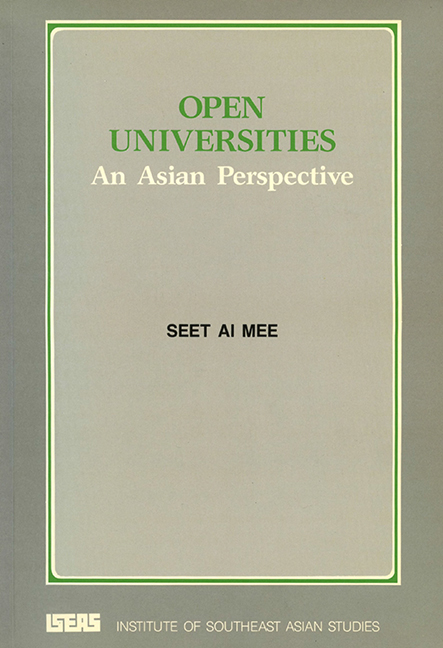Book contents
- Frontmatter
- Contents
- Acknowledgements
- I Introduction
- II Open Universities
- III The Quality of Distance Education
- IV Science and Technology Teaching
- V Continuing Professional Education
- VI Costs of Distance Education
- VII Concluding Remarks
- Notes
- Select Bibliography
- Abbreviations
- Member Institutions of the Association of Asian Open Universities
- THE AUTHOR
VII - Concluding Remarks
Published online by Cambridge University Press: 21 October 2015
- Frontmatter
- Contents
- Acknowledgements
- I Introduction
- II Open Universities
- III The Quality of Distance Education
- IV Science and Technology Teaching
- V Continuing Professional Education
- VI Costs of Distance Education
- VII Concluding Remarks
- Notes
- Select Bibliography
- Abbreviations
- Member Institutions of the Association of Asian Open Universities
- THE AUTHOR
Summary
It is pertinent at this stage to recapitulate on the strengths and weaknesses of distance tertiary education institutions.
Distance education is flexible and accessible. Its courses do not impose rigidities. It reaches people in their homes and provides large numbers of people with access to education.
Several institutions produce very high quality teaching materials. What is unique in the system is that all students benefit from the same material unlike in conventional university teaching, where quality varies from lecturer to lecturer, and from university to university.
The rapid developments in technology have strengthened the potential of distance education. The electronic and technology developments lend greater flexibility and innovation. As the cost of these technologies is decreasing and electronic media are improving and growing, they will be used extensively in the near future for the support of distance education.
Distance education has its weaknesses. A major weakness is the isolation and loneliness of the learner. The home-based student, deprived of peer group interaction, is also deprived of learning from others. It is therefore worthy to note that in countries where there are well-developed regional study centres and good support systems for students, the success rate for undergraduate studies is correspondingly high. It is herefore necessary to develop and strengthen study centres to support distance learning in Asia.
Another important problem is that in the eyes of the conventional academic, and many political leaders, who were trained in conventional universities, distance education does not have parity of esteem with formal systems. It is sometimes viewed as a fringe form of tertiary education.
Media broadcast material and actual broadcast time costs are high for distance education. Compounded to the economic cost is the difference in the philosophies between education and broadcasting. In the former, repetition and getting the lesson across is important, whereas broadcast producers are on the lookout for novelty.
- Type
- Chapter
- Information
- Open UniversitiesAn Asian Perspective, pp. 29 - 30Publisher: ISEAS–Yusof Ishak InstitutePrint publication year: 1992

